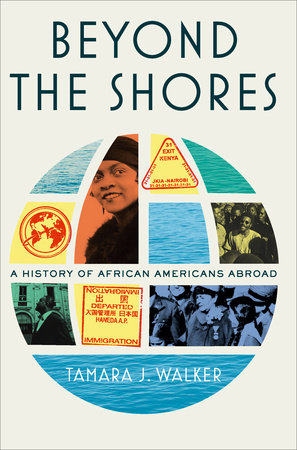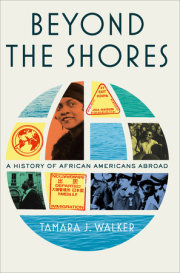Chapter 1
The Transatlantic SensationFlorence Mills,
Paris and London, 1920s
By the time she faced out into the crowd for her Paris debut, Florence Mills was already a stage veteran. Though barely thirty years old, she had a lifetime of performances under her belt, from the neighborhood juke joints where she’d belted out ballads as a toddler to the Broadway theater where she first performed Blackbirds, a musical revue that made her a star. That same show had brought her to the Café des Ambassadeurs on the Champs-Élysées (a combination nightclub and restaurant with a large dance floor separating the stage and dining area) on this night in May 1926. Now the beautiful young woman with the face-framing spit curls was poised for something even bigger. She stood backed by a hundred-person chorus and orchestra and flashed a dazzling smile at the audience, awaiting the drumroll that was her cue. Then she took over with the song, dance, and comedy routines that were as familiar to her at this point as her own heartbeat. “Une artiste véritable,” one paper enthused the next day.
The comparisons were inevitable. “Here is Florence Mills, who right away makes us think about Josephine Baker,” wrote the Parisian weekly Le plaisir de vivre. One reason for the association was the circumstances of both women’s arrival in Paris: Florence’s Blackbirds revue had opened in the city less than a year after Baker headlined La revue nègre at the Théâtre des Champs-Élysées, which kick-started her own French ascent. Both women also had signature hairstyles that made them easily identifiable, both were fountains of youthful charisma who entranced scores of admirers, and both were generating buzz for their energetic performances onstage. For all their similarities, though, the Parisian paper seemed intent on fetishizing their differences: Florence’s complexion was “café au lait” (with more lait, the paper insisted to male readers, than café, as if to give them permission to lust after her without needing to interrogate their racial preferences) in contrast to Baker’s “café noir”; Florence was “civilisée” while Baker was “sauvage”; and Florence’s singing and stage persona called to mind the French actress and singer Alice Cocéa and the Hungarian American Dolly Sisters duo, whereas when it came to Baker, “On ne la voit pas blanche. Négresse elle est, négresse elle restera.” (One cannot see her as white. Black she is, Black she will stay.)
As far as the paper was concerned, the verdict was in: “Si Florence Mills était un visage pâle, elle serait le plus formidable numéro de le Amérique.” (If Florence Mills had a paler face, she would be the hottest number in America.) The United States didn’t know what a good thing they had in her.
Regardless of Florence’s perceived advantages over Baker (which were themselves a product of French racist thinking and a sign that, compared with white Americans, locals weren’t quite as evolved as they wanted to believe), it was the latter who would eventually become synonymous with Paris in the 1920s, while Florence wound up little more than a relative footnote. Bringing Florence back into the mainstream spotlight does more than simply renew attention to her remarkable life and career. It’s an opportunity to remember that Baker was just one of countless African American performers who made their way to the City of Light, left indelible marks on its cultural landscape, and turned it into a destination for new forms of music, dancing, and cross-cultural mingling in ways that would be felt for decades to come.
Florence and her Blackbirds crew also responded to calls to take their talents beyond Paris, as word spread via audience members and European newspapers about the arresting new show. It wasn’t long before the floodgates opened, with African American performers accepting invitations to grace cabaret and theater stages in London, Vienna, Berlin, and beyond. As the French German poet Ivan Goll put it in a 1926 essay titled “The Negroes Are Conquering Europe,” in response to the force of the moment: “The Negroes are conquering Paris. They are conquering Berlin. They have already filled the whole continent with their howls, with their laughter. And we are not shocked, we are not amazed: on the contrary, the old world calls on its failing strength to applaud them.”
Born Florence Winfrey in 1896 to formerly enslaved parents, she was one of eight children who all crowded into a small apartment in a wood-framed row house on Goat Alley in Washington, D.C. A notoriously poor and densely populated “hidden community”—one of hundreds carved out of alley-facing rear lots to accommodate the city’s growing population after the Civil War—Goat Alley was tucked into the square formed by Sixth, Seventh, L, and M streets in northwest D.C. (today’s Shaw neighborhood). As recently as the 1880s, the community was home to white immigrants from Germany, Ireland, and elsewhere in Europe, but by the early 1900s, nearly all of its four hundred residents were Black, including the Winfrey family.
Like the other alley communities in D.C., Goat Alley was cut off from the rest of the city in nearly every way. Neither sunlight nor streetlights penetrated its dark corners, and because there was usually only one way in and one way out, it saw no casual pedestrian traffic. The only people who crossed Goat Alley’s threshold were its residents and those who preyed on them, like the mercenary landlords who ruled the neighborhood despite living in other parts of town. They came through at regular intervals to demand exorbitant rents for tiny units in cramped row houses that lacked water and sewage and were plagued by “leaky roofs, broken and filthy ceilings, [and] dilapidated floors,” all of which made the homes there generally “unfit for human habitation.”
Another source of trouble for the residents of Goat Alley was the constant intervention of white police officers and reformers who saw the community and others like it as breeding grounds for “vice, crime, and immorality.” The Gerry Society, an organization that was co-founded by the lawyer Elbridge Thomas Gerry for the ostensible purpose of preventing cruelty to children and operated in East Coast cities, posed a particular threat. Agents, known as Gerry men, made it their mission to keep children away from supposedly immoral environments like dance halls, theaters, and the poor neighborhoods that tended to surround such establishments. The Gerry men treated poverty itself as an immoral act, separating poor children from their families in ways that often caused more suffering than even the worst financial hardships.
Before they became marquee names, Buster Keaton, Milton Berle, and Al Jolson (who would later make a career painting his face coal black and depicting Black people as hapless minstrels) were all caught in the Gerry men’s crosshairs, pulled from the stages of local performance venues, held in the organization’s custody, and eventually placed in Catholic institutions (even if they had no connections to the faith, like Jolson, who was Jewish). The same fate would soon befall young Florence.
Growing up on Goat Alley, Florence earned the nickname “Baby Flo” when, at just three years old, she accompanied her mother to pick up laundry around the neighborhood and captured attention for singing Irish ballads like “Mother Machree” and “Little Grey Home in the West” in a high-pitched voice that would become her trademark. She learned the lyrics from older sisters Olivia and Maude, who for their part likely learned the songs from the white immigrants who once lived in their neighborhood. Baby Flo soon found early success singing and dancing onstage at northwest D.C.’s popular Bijou Theater; that is, until the Gerry men came along when she was nine years old. They arrested her for underage performing and shipped her off to an institution run by local nuns. All this occurred against the wishes of Florence’s family, who knew little about where she was being held and had no way of being able to visit her.
The experience conspired with the more quotidian hardships of life on Goat Alley to sour the Winfreys on living in Washington. When Florence was released from the institution after about a year, the family packed up and moved to New York. There was perhaps another draw to the city: It was a much bigger market for the sisters to try their luck as stage performers. Indeed, while living in New York, Florence, Olivia, and Maude became known as “the Mills Sisters,” adopting the last name Florence had used since the beginning of her career after borrowing it from the doctor listed on her birth certificate, as they began singing and dancing in venues throughout Harlem, which in the early decades of the twentieth century was becoming a hub for African Americans from the South and Black people from across the Caribbean, who all came together to create a neighborhood filled with diverse traditions and a destination for live music and cultural events. The crowds loved all three Mills sisters, but Florence was the clear standout. By the time she was twenty, she decided, in classic American fashion, to try to make her fortune out west.
Copyright © 2023 by Tamara J. Walker. All rights reserved. No part of this excerpt may be reproduced or reprinted without permission in writing from the publisher.








